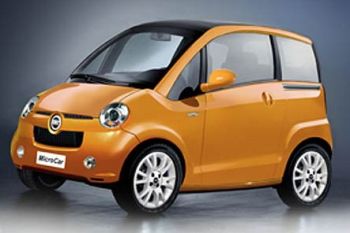|
Fresh new
proposals for a Fiat 'microcar', just 2.65 metres in length,
have been revealed by Italian motoring magazine Quattroroute.
Fiat are keen to
build on their famous tradition of producing innovative, fun
and fashionable small cars, and a contender in the
ever-expanding 'micro' segment is uppermost in their minds.
At the Geneva Salon in 2004 Fiat introduced the Trepiuno
concept, an innovative 3+1 seat concept that developed the
theme of the original and highly-successful Fiat 500, a tiny
'city' car that has rightfully claimed its place in the
automotive history books. Geneva is regarded as the world's
most important motor show, and the cute little Trepiuno was
the show stopper, creating such as positive and enthusiastic
reaction that Fiat's senior management were convinced that
building a microcar was the route to follow.
However, the
Trepiuno concept in the format it was presented to the world
in Geneva, was considered too long, too expensive to
manufacture, and too close in its dimensions to the Fiat
Panda, to ever be seriously considered for full production
by Fiat's management, who never, despite the overwhelming
public and press enthusiasm, warmed to the concept. Rather,
they wish to create a car that will sit clearly below their
award-winning Panda, as a genuine and highly cost-effective
city transportation method.
The new 'microcar' will thus go
head-to-head with Smart's tiny city 'Coupé', the FourTwo,
the well established market leader in this segment. Whereas
though the FourTwo is a 'lifestyle' product overtly wearing the
Mercedes-Benz badge, and as such commands a premium price
tag, Fiat want to create a car that will be more widely
affordable and truly innovative. Fiat's engineers
don't regard the current Smart FourTwo, itself due to be
replaced in 2007, as offering any particularly great value
or very much technical ability, and firmly believe that they
can offer a much more exciting and innovative option at a
substantially better price, and in the process create a
modern-day replacement for the iconic 1950s Fiat 500.
The Italian carmaker wants to produce a car that once again
will see the historic concern breaking the small car mould,
pushing the boundaries forward, and, in their new
Fiat-Lancia design chief, Frank Stephenson, who arrives
fresh from a stint as head of design at the Ferrari-Maserati
Group, they have a visionary thinker who wants to stamp his
mark on this segment for the first time.
|
 |
|
Innovations on the Microcar will include Fiat's
trademark all-glass roof and a sliding door for easy
access in confined spaces, very similar in principle
to that which has been pioneered by Peugeot on
their 1007. Images: Quattroruote. |
|
|

 |
|
Fresh new
proposals for an innovative and ground-breaking new 'microcar'
from Fiat, which will be just 2.65 metres in length,
have recently been revealed. Images: Quattroruote. |
|
|
For this reason travelling the now-popular 'retro' route
with the Trepiuno, designed before
he took over the design reigns at Fiat, was never an option
for Stephenson, who can count designing the BMW MINI as one
of his many achievements, and so it was an idea that was
quickly dismissed. To achieve these new ends Fiat see the passenger carrying
restrictions imposed by the two-seat Smart FourTwo as
unfavourable, and they want their contender to squeeze four
seats into its tiny frame, which Quattroruorte
magazine believe will be just 2.65 metres in length, and
1.70 metres high. This proposed height will be enough to get
four seats into the car, which will be propelled by the
highly compact and efficient 1.3-litre Multijet diesel
engine, positioned behind the high-positioned rear seats,
and driving the rear wheels. Luggage stowage space will also
be available above the engine and gearbox, and on the back
seats which will be swiftly and simply adaptable to provide
a secondary function of increasing storage capacity,
accessible from the high tailgate. The front bonnet will
also open to offer further luggage space.
Innovations will
include Fiat's trademark all-glass roof and a sliding door
for easy access in confined spaces, very similar in
principle to that which has been pioneered by Peugeot on
their compact new 1007 model. Prior to the dissolution of
the GM-Fiat partnership earlier this year, Fiat had also
closely looked at the technology and practices used by Gm to
develop their efficient Trixx 'microcar' concept. The
possibility of platform and technology sharing still remains
an option for a car that Fiat will build in Poland alongside
the Panda, and which they estimate would sell in the region
of 100,000 to 150,000 units per year.
|
|
|
|
![]()
![]()